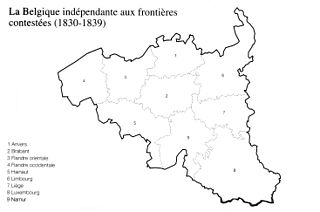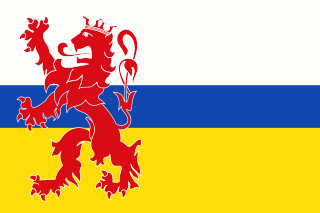
Limburg is the southernmost of the 12 provinces of the Netherlands. It is in the southeastern part of the country, stretched out from the north, where it touches the province of Gelderland, to the south, where it internationally borders Belgium. Its northern part has the North Brabant province to its west. Its long eastern boundary is the international border with the German state of North Rhine-Westphalia. Much of the west border runs along the River Maas, bordering the Flemish province of Limburg, and a small part of the Walloon province of Liège. On the south end, it has borders with the Flemish exclave of Voeren and its surrounding part of Liège, Wallonia. The Vaalserberg is on the extreme south-eastern point, marking the tripoint of Netherlands, Germany and Belgium.

Limburg is a province in Belgium. It is the easternmost of the five Dutch-speaking provinces that together form the Region of Flanders, one of the three main political and cultural sub-divisions of modern Belgium.

Tongeren is a city and municipality located in the Belgian province of Limburg, in the southeastern corner of the Flemish region of Belgium. Tongeren is the oldest town in Belgium, as the only Roman administrative capital within the country's borders. As a Roman city, it was inhabited by the Tungri, and known as Atuatuca Tungrorum, it was the administrative centre of the Civitas Tungrorum district. The city is a member of the Most Ancient European Towns Network.

The Jeker is a river in Belgium and in the Netherlands. It is a left-bank tributary to the river Meuse. The source of the Jeker is near the village of Geer, in the Belgian province of Liège. The river is approximately 54 kilometres (34 mi) long, of which about 50 kilometres (31 mi) is in Belgium and 4 kilometres (2.5 mi) in the Netherlands, where it flows into the river Meuse at Maastricht (Netherlands).
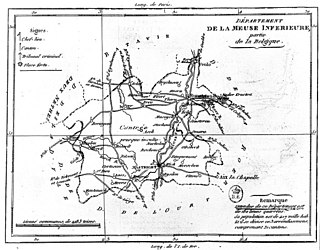
Meuse-Inférieure was a department of the First French Empire in present-day Belgium, Netherlands and Germany. It was named after the river Meuse. Its capital was Maastricht. Its territory corresponded largely with the present-day provinces of Belgian and Dutch Limburg.
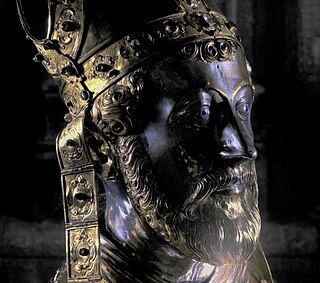
Saint Servatius was bishop of Tongeren —Latin: Atuatuca Tungrorum, the capital of the Tungri—. Servatius is patron saint of the city of Maastricht and the towns of Schijndel and Grimbergen. He is one of the Ice Saints. His feast day is May 13.
Koen Daerden is a Belgian former football player and current coach, who currently works as sporting director for the youth or head of the youth department at Racing Genk.

The Arrondissement of Tongeren is one of the three administrative arrondissements in the Province of Limburg, Belgium. It is both an administrative and a judicial arrondissement. However, the Judicial Arrondissement of Tongeren also comprises the municipalities of Bocholt, Bree, Kinrooi, Meeuwen-Gruitrode, Dilsen-Stokkem and Maaseik in the Arrondissement of Maaseik and the municipalities of As, Genk, Opglabbeek and Zutendaal in the Arrondissement of Hasselt.
The Diocese of Tongeren was an Ancient bishopric and Belgium, now a latin titular bishopric, in present Belgium.

Monulph was a sixth-century bishop of Tongeren and Maastricht, and is revered as a Roman Catholic saint.
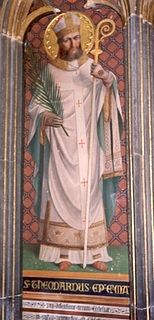
Theodard of Maastricht was a seventh-century bishop of Maastricht-Liège, in present-day Netherlands. As Theodard was murdered while on his way to protest the plundering of his diocese by Frankish nobles, he is considered a martyr. His feast day is 10 September. Theodard was uncle to his successor Lambert of Maastricht, and therefore brother or brother-in-law to Robert II, Lord Chancellor of France.

The Roman Catholic Diocese of Liège is a diocese of the Latin Rite of the Roman Catholic church in Belgium. The diocese was erected in the 4th century, and has a long and complicated history. Currently the diocese is a suffragan of the Archdiocese of Mechelen-Brussels. Its modern version covers the same territory as the Belgian province of Liège, but it was historically much larger.
The Most Ancient European Towns Network is a working group of the oldest cities in Europe. It was founded in 1994, with the idea coming from the town of Argos in Greece, presented to the European Union. The group exists to discuss issues such as archaeological research, tourism and incorporating monuments into urban planning.

The Duchy of Limburg was a European polity created in 1839 from parts of the Dutch Province of Limburg as a result of the Treaty of London. Its territory was the part of Limburg that remained Dutch, with the exception of the cities of Maastricht and Venlo. The duchy was a province of the Kingdom of the Netherlands and at the same time was a member of the German Confederation.
The Arrondissement of Maastricht was an arrondissement of the United Kingdom of the Netherlands until the Treaty of London in 1839. It was a part of the Province of Limburg, which also included the Hasselt and Roermond. It was centred on the city of Maastricht.
Partial legislative elections were held in Belgium on 11 June 1839. In the Senate elections Catholics won 27 seats and Liberals 12. Voter turnout was 66.4%, although only 23,661 people were eligible to vote.
Hasselt-Tongeren-Maaseik was a constituency used to elect members of the Belgian Chamber of Representatives between 1995 and 2003.
Tongeren-Maaseik was a constituency used to elect members of the Belgian Chamber of Representatives between 1900 and 1995.

